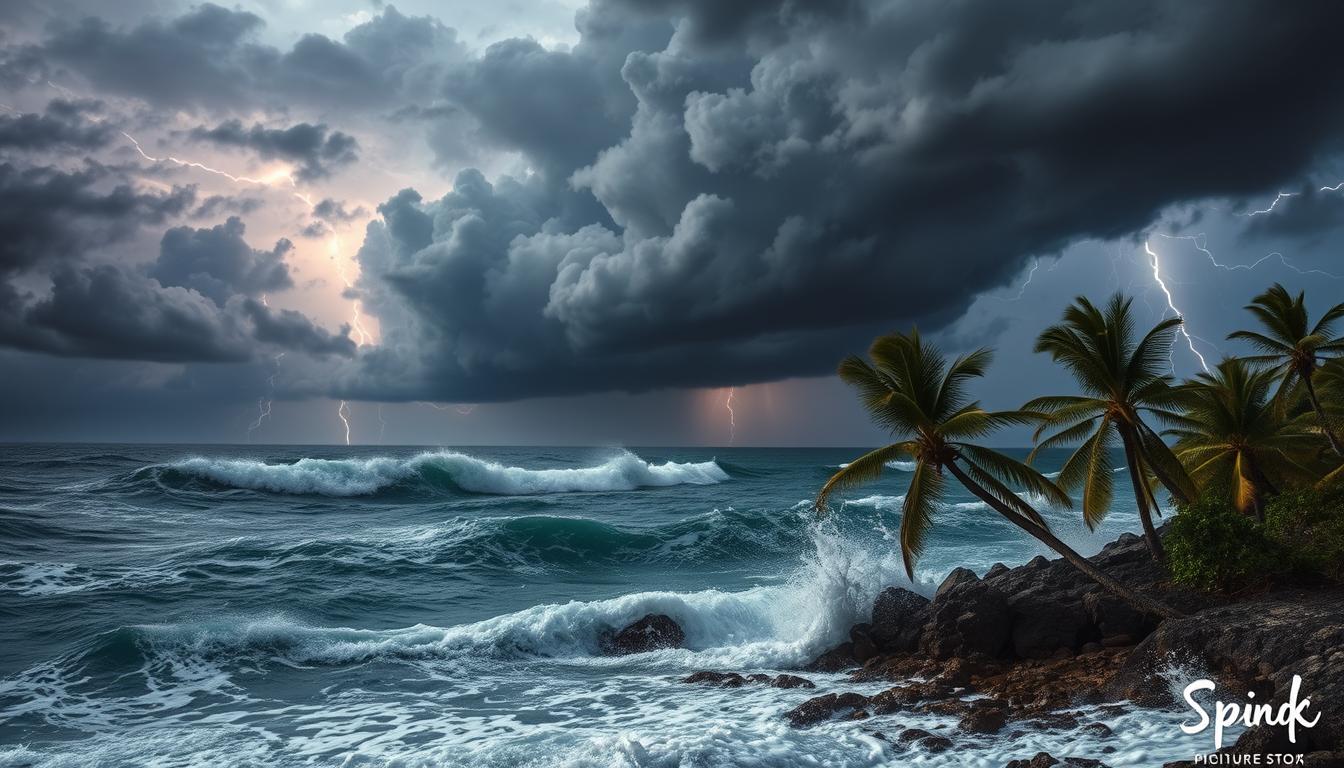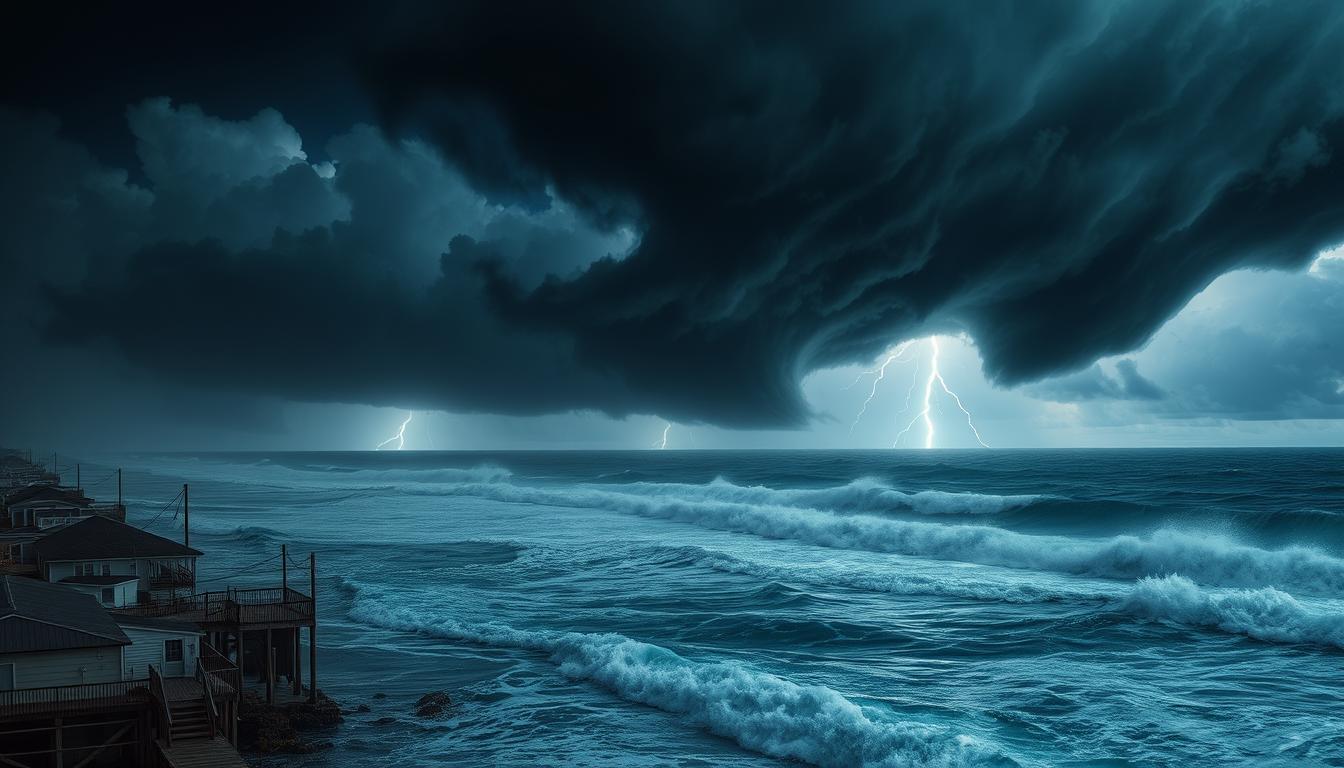As we prepare for another busy hurricane season, a big question is: Are you ready for the storm1? With1 the peak season in September and October, and1 storms developing fast, it’s crucial to stay informed and prepared. Our real-time hurricane tracker is your key to understanding these powerful storms.
We’ll give you the latest forecasts and satellite images to keep your family safe. Whether it’s1 warnings for Alabama or1 flood watches for East Alabama, we’ve got you covered. Our detailed updates will help you stay ahead of the storm.
Key Takeaways
- Stay informed with real-time hurricane tracking and forecasts
- Prepare for potential1 flooding1, storm surge, and1 powerful wind gusts
- Heed evacuation orders and take necessary precautions to protect your family
- Monitor1 sea-surface temperatures and other1 tropical waves in the Atlantic
- Develop an emergency plan and stock up on essential supplies
Tracking Hurricane Helene’s Rapid Intensification
Hurricane Helene is moving towards the Florida Gulf Coast, and weather experts are watching closely. Satellite images and wind speed data show Helene could become a Category 3 storm in just 12 hours on Thursday2. The Gulf of Mexico’s warm waters and Helene’s path over the Loop Current are causing this quick growth2.
Satellite Imagery and Wind Speed Observations
Satellite images show Helene west of Key West on Thursday morning. They reveal a well-structured storm with tall thunderstorms on the east side2. Helene has been upgraded to a Category 2 storm, with winds of 100 mph and a pressure of 960 mb3. Forecasters say it will move north or north-northeast faster in the next 24 hours3.
Forecasted Landfall in Florida’s Big Bend
Helene is expected to hit the Big Bend area of Florida’s Gulf Coast as a Category 3 or 4 storm4. The hurricane center warns of strong winds and storm surges of 15 to 20 feet near landfall4. Rainfall will be heavy, with 6 to 12 inches expected in the southeastern U.S., and up to 18 inches in some areas, causing flash and urban flooding4.
Governor Ron DeSantis is worried about Helene’s quick growth, calling it a major concern2. Meteorologist Brian McNoldy stresses the importance of understanding weather forecast maps. He warns that being outside the cone does not mean you are safe during a storm2.
| Hurricane Data | Current Status |
|---|---|
| Hurricane Category | Category 2 |
| Location | Approximately 320 miles southwest of Tampa |
| Maximum Sustained Winds | 100 mph |
| Minimum Central Pressure | 960 mb |
| Expected Storm Surge | 15-20 feet near landfall |
| Rainfall Forecast | 6-12 inches, with isolated totals around 18 inches |
Catastrophic Storm Surge and Flooding Risks
Hurricane Helene is heading towards Florida’s Gulf Coast, bringing a big threat of storm surge and flooding. Forecasters say Helene could cause a “nightmare surge scenario” in Apalachee Bay. They warn of water levels up to 20 feet above ground567.
The National Hurricane Center warns that Helene could become a powerful Category 4 hurricane. It could have winds over 130 mph7. This storm could cause a huge storm surge, flooding coastal areas and putting thousands at risk67.
Apalachee Bay Facing a “Nightmare Surge Scenario”
The National Weather Service in Tallahassee has issued a serious warning. Apalachee Bay is facing a “nightmare surge scenario” from Hurricane Helene. The Florida Panhandle, from Carrabelle to the Suwannee River, could see storm surges up to 15 to 20 feet. This could lead to severe flooding567.
- Forecasters predict the storm surge could reach up to 20 feet above ground level in some areas of the Apalachee Bay567.
- The surge is expected to be accompanied by destructive waves, posing a grave threat to coastal communities5.
- Residents in the affected regions have been urged to take any evacuation orders seriously and seek higher ground to avoid the potentially catastrophic conditions67.
“Apalachee Bay is facing a ‘nightmare surge scenario’ and residents should take any evacuation orders seriously.”
As Hurricane Helene gets stronger, the threat of storm surge and flooding in the Florida Big Bend region is serious. Authorities have emergency resources ready. They are urging everyone to follow evacuation orders to stay safe67.
Hurricane Helene’s Widespread Wind Field
Hurricane Helene is heading towards the Southeast U.S. and is expected to be very dangerous. It could become a Category 4 storm with winds of 130 mph by the time it hits Florida6. The storm’s large wind field will cause severe conditions across Florida, including inland areas6.
Researcher Phil Klotzbach says Helene’s wind field will be among the largest to hit the Southeast U.S. in years8. Only three Gulf hurricanes were bigger: 2017’s Irma, 2005’s Wilma, and 1995’s Opal8. Tropical storm-force winds are already hitting the Florida Keys and will reach South Florida by mid-morning Thursday8.
Experts warn of a deadly storm surge from the hurricane. The Panhandle could see 15 to 20 feet of water above ground level8. The whole Florida coast is under warnings, including hurricane warnings from Tampa Bay to Mexico Beach8.
As Helene gets stronger, the risk of long power outages, fallen trees, and flooding grows8. People in the storm’s path should follow evacuation orders and take steps to protect themselves and their homes9.
Evacuation Orders and Preparations Underway
As Hurricane Helene heads towards Florida’s west coast, state and local authorities are working hard to keep people safe. Governor Ron DeSantis has declared a state of emergency in 61 of Florida’s 67 counties. President Biden has also approved Florida’s emergency declaration10. Several counties on Florida’s west and northwestern coasts have ordered mandatory evacuations. Schools are planning to close or reduce hours10.
Mandatory Evacuations in Coastal Areas
With Hurricane Helene expected to become a Category 3 major hurricane by early Thursday afternoon, coastal communities are evacuating10. Mandatory evacuation orders have been issued for parts of 16 counties. Governor DeSantis is urging residents in vulnerable areas to seek safer ground10. People are advised to leave the area as soon as possible to avoid storm surge, flooding, and destructive winds.
Sandbag Distribution and School Closures
In preparation for the storm, municipalities across Florida have set up sandbag distribution sites10. Some cities are also offering free parking in public garages to help people prepare10. Schools in the affected regions have announced closures or reduced hours to ensure student and staff safety.
As Hurricane Helene’s path and intensity change, state and local officials are staying vigilant in protecting Floridians11. Previous forecasts suggest a surge higher than Hurricane Idalia’s. The NHC has warned about tornadoes forming over western Florida and southern Alabama10. Residents are urged to monitor the situation closely and follow all evacuation orders and safety guidelines.
“We are preparing for an unprecedented amount of damage. This storm has the potential to be catastrophic, and we are urging all residents to take it seriously and heed the warnings from local officials.” – Tallahassee Mayor
Tracking the Hurricane Tracker
As Hurricane Helene gets stronger and threatens the Gulf Coast, we’re watching the latest updates from the National Hurricane Center12. It’s expected to become a major hurricane with winds over 111 mph when it hits Florida’s northwestern coast12. The storm could bring storm surges of up to 20 feet in Apalachee Bay, causing catastrophic damage12.
Latest Forecast Models and Updates
Hurricane Helene is now about 350 miles southwest of Tampa, moving north-northeast at 12 mph with winds of 90 mph12. It’s the eighth named storm of the Atlantic hurricane season, which started on June 112. Tropical Storm Isaac has also formed in the Atlantic and could become a hurricane by the end of the week13. Former Hurricane John has reformed as a tropical storm in the Pacific, threatening Mexico’s western coast12.
The 2024 Atlantic hurricane season is expected to be very active, with 17 to 25 named storms predicted13. Last year saw 20 named storms, more than the average of 1413. The El Niño pattern is fading, making conditions better for storms to form and get stronger13.
| Metric | Value |
|---|---|
| Number of Named Storms in 2024 | 17 to 25 |
| Number of Named Storms in 2023 | 20 |
| Average Number of Named Storms | 14 |
As Hurricane Helene gets closer, Gulf Coast residents should watch the latest forecasts and follow evacuation orders14. It’s forecasted to hit Florida’s Gulf Coast as a Category 4 storm, bringing strong winds, deadly surges, and flooding14.
“The storm surge caused by Hurricane Helene could reach up to 20 feet in certain areas, which is a nightmare scenario for the coastal communities in its path.” – National Hurricane Center Spokesperson
People in low-lying areas have been ordered to evacuate, and 61 counties in Florida have declared a state of emergency14. With Helene intensifying fast, it’s vital for everyone in the area to stay informed and take safety steps141213.
Tallahassee in Helene’s Direct Path
Hurricane Helene is heading straight for the Florida Panhandle, with Tallahassee in its direct path8. The storm is expected to get much stronger, with winds reaching 130 mph by Thursday8. People in Tallahassee should get ready for severe wind damage, storm surge, and flooding.
Tallahassee’s spot in the hurricane’s path is very worrying. Only three Gulf hurricanes since 1988 were as big as Helene8. The city could face the hurricane’s strongest winds, causing power outages and damage to buildings.
Florida’s Governor Ron DeSantis has started emergency plans. Schools and universities are closed8. People in Tallahassee need to finish their storm prep and follow any evacuation orders.
Hurricane Helene’s threat to Tallahassee is getting worse15. The forecast shows Helene moving through the panhandle on Thursday night, with Tallahassee in the middle15. The area should prepare for dangerous winds, storm surge, and flooding.
Potential for Inland Flooding and Power Outages
Hurricane Helene is heading towards the Southeastern U.S., causing worry about inland flooding and power outages. Forecasters say Helene could dump up to 18 inches of rain in some areas5. This heavy rain could lead to deadly flash flooding and major river flooding5.
Heavy Rainfall Forecast for Southeastern U.S.
The Weather Prediction Center has warned Alabama, Georgia, and Florida about high flood risks until Friday morning5. Helene’s strong winds could also cause long-lasting power outages in the Southeast5. Experts fear Helene could hit a major Southern city hard, like Atlanta, Georgia68.
The National Weather Service warns of “extensive impacts” and a “unprecedented event” for north and central Georgia68. They predict Helene will be a Category 4 storm with winds of 100 mph. People are advised to evacuate and prepare for long power outages and dangerous flooding.
“Helene could potentially be the worst strike on a major Southern inland city in 35 years.”
South Florida Braces for Tropical Storm Conditions
South Florida is getting ready for Hurricane Helene’s effects, even though it’s not directly in the storm’s path3. The area could see winds up to 345 miles from Helene’s center, with gusts of 60 mph locally3. The Florida Keys are under coastal flood warnings, with 1 to 3 feet of storm surge possible at high tide3.
The tri-county area of South Florida is already seeing gusty, tropical rain bands3. Thursday afternoon is expected to be very windy3. Heavy rain bands will keep coming through Friday, with 2 to 4 inches of rain possible3.
Coastal Flood Warnings and High Wind Advisories
The National Weather Service has issued a coastal flood warning for the Florida Keys, with storm surge up to 3 feet expected3. High wind advisories are in effect for Miami-Dade and Broward Counties, with gusts up to 50 mph forecasted, and up to 60 mph in the Keys3.
Residents in South Florida should keep an eye on weather updates and follow any evacuation orders or warnings3. It’s important to take precautions to stay safe and protect property during this storm3.
“The storm surge in the Florida Keys could be a real nightmare scenario, with significant flooding expected in low-lying coastal areas.”
| County | Wind Gusts | Storm Surge |
|---|---|---|
| Miami-Dade | Up to 50 mph | N/A |
| Broward | Up to 50 mph | N/A |
| Florida Keys | Up to 60 mph | 1 to 3 feet |
Conclusion
Hurricane Helene is heading towards Florida, and it’s vital for everyone to follow evacuation orders. The storm is expected to grow stronger, reaching Category 3 from Category 116. Airlines like American Airlines and Delta Air Lines are preparing for the storm16.
Storm surge and flooding are big worries, especially for Apalachee Bay. The wind field of Hurricane Helene will also affect a wide area, including western North Carolina17. People in danger zones should secure their homes and stock up on supplies.
Staying informed and taking action can keep our communities safe. Thanks to hurricane preparedness and weather tracking, we’re better equipped to face the storm1617. Our thoughts are with those in the storm’s path. We’re all in this together.
















Leave a Reply